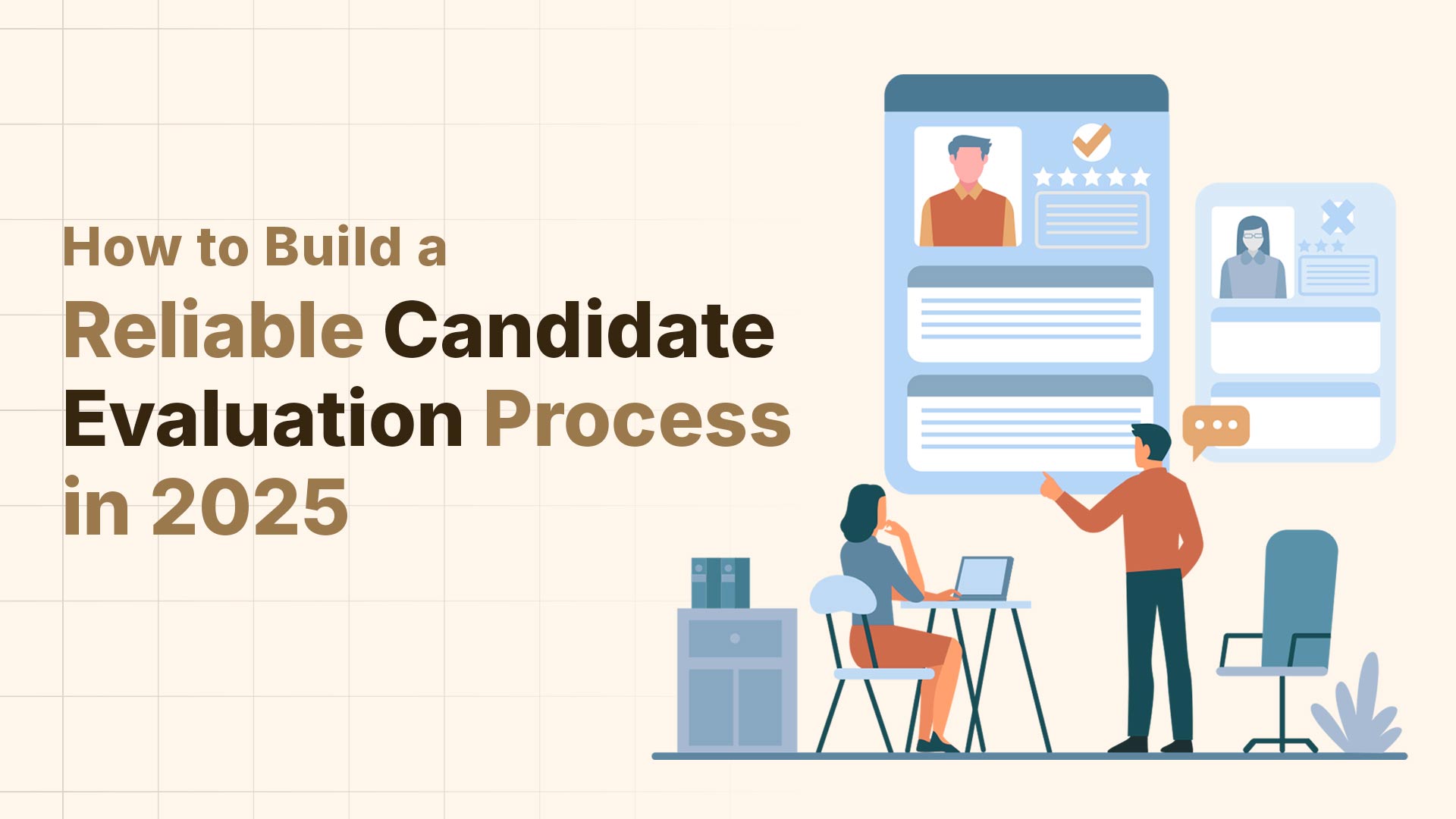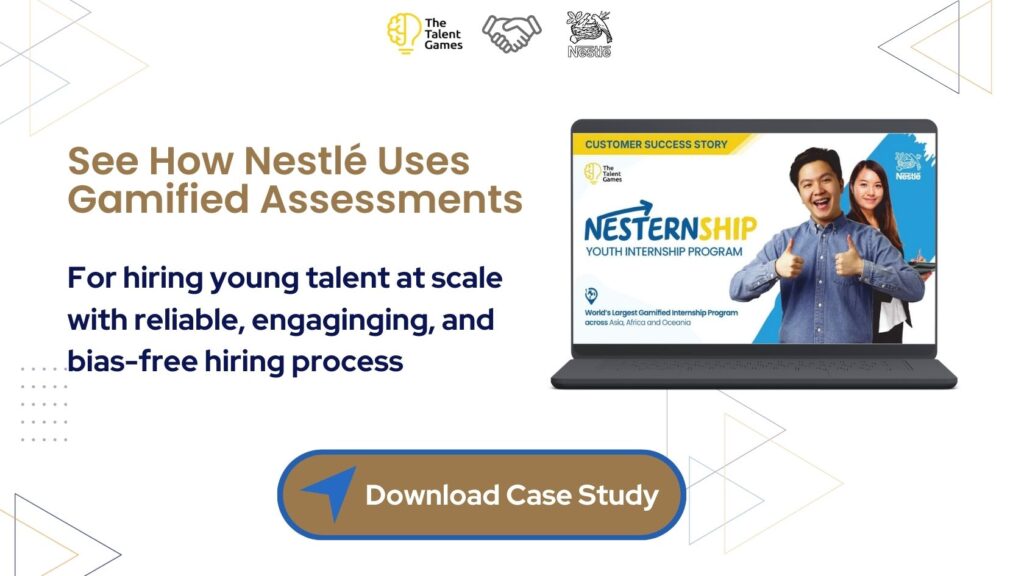This blog explores what makes a reliable candidate evaluation process in 2025 and how you can improve it using science-backed tools like gamified assessments.
Hiring in 2025 goes beyond resumes and checklists. The real challenge for you as a recruiter is ensuring your hires fit the role, the culture, and the long-term goals of the business. A reliable candidate evaluation process does exactly that, consistently and without bias.
Yet many companies still rely on outdated hiring practices that are vulnerable to subjectivity and inconsistency. So, what does a reliable, future-ready evaluation process actually look like?
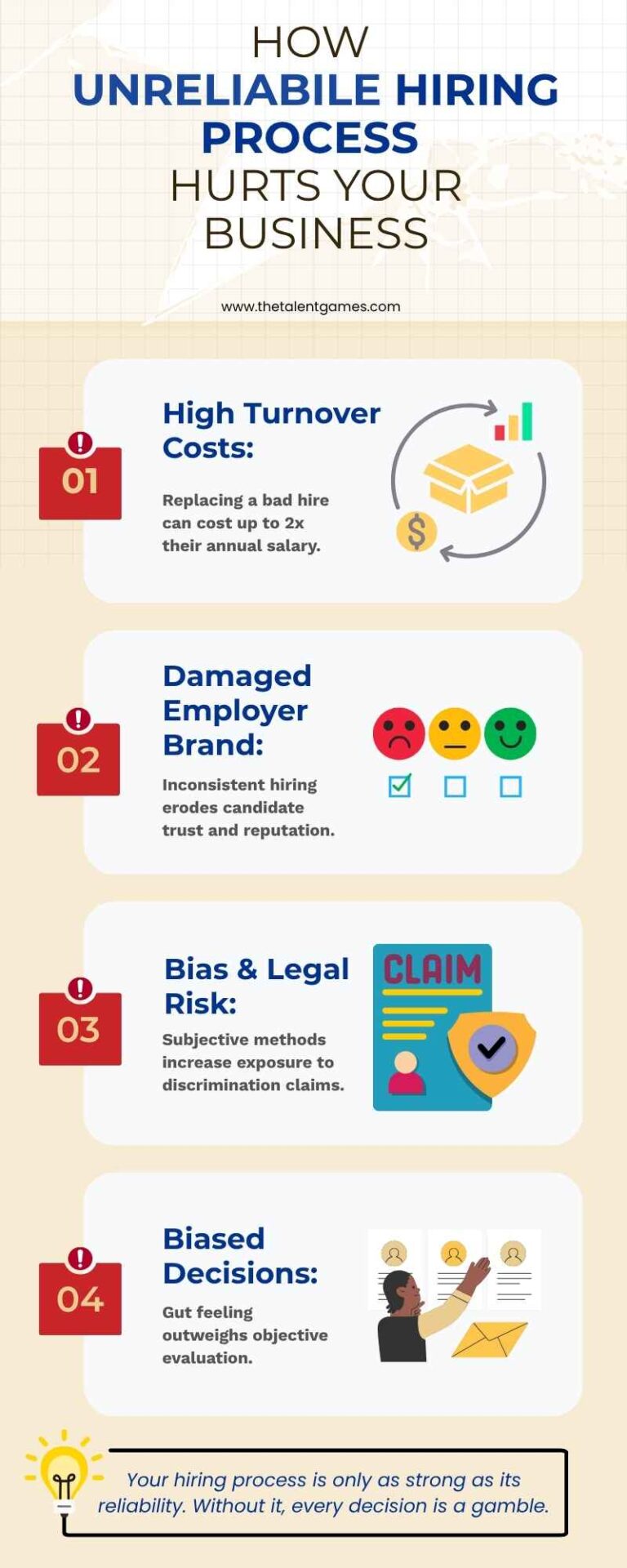
What Is a Reliable Candidate Evaluation Process?
A reliable candidate evaluation process is one that delivers consistent, predictive, and bias-reduced results.
That means different evaluators using the same process should arrive at the same conclusions. The results should also correlate with actual job performance after hiring.
It’s not just about being fair, it’s about making smarter, data-driven decisions that reduce turnover, boost performance, and improve candidate fit.
Why Reliability in Hiring Still Fails Today
Despite evolving HR tech, many companies in 2025 still rely on unstructured interviews, gut-feel decisions, and outdated assessments. These methods invite interviewer bias, halo effects, and inconsistent scoring, undermining reliability from the start.
Such flaws often lead to poor hiring choices. When evaluations lack structure, bad hires become more likely, and costly. A LinkedIn report estimates the average cost of a bad hire at $14,900, largely due to underperformance and attrition. These losses reflect a deeper issue: hiring systems that simply don’t evaluate candidates in a reliable way.
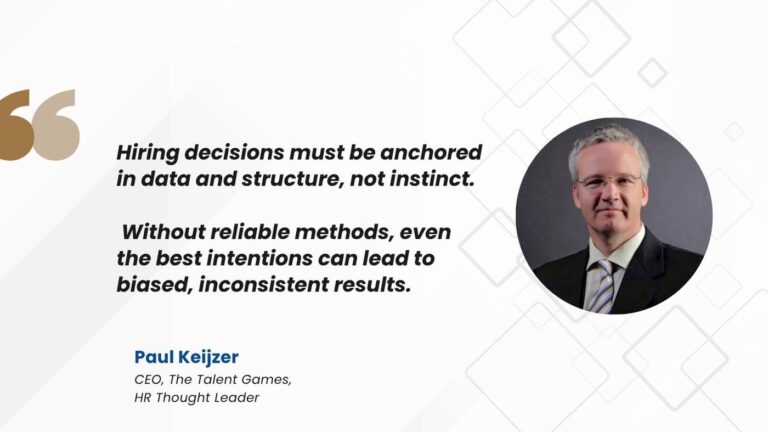
Key Elements of a Reliable Candidate Evaluation Process
A reliable evaluation process doesn’t just measure the right things, it does so fairly, repeatedly, and with minimal bias. To achieve this, companies should focus on a few core principles:
- Standardization: Ensure every candidate experiences the same evaluation structure.
- Objectivity: Replace subjective opinions with data-backed scoring.
- Scientific validation: Use tools that are statistically proven to be reliable.
- Job relevance: Assess only what truly predicts job performance.
- Candidate engagement: Keep the process motivating and stress-free.
When these elements come together, hiring becomes both consistent and predictive.
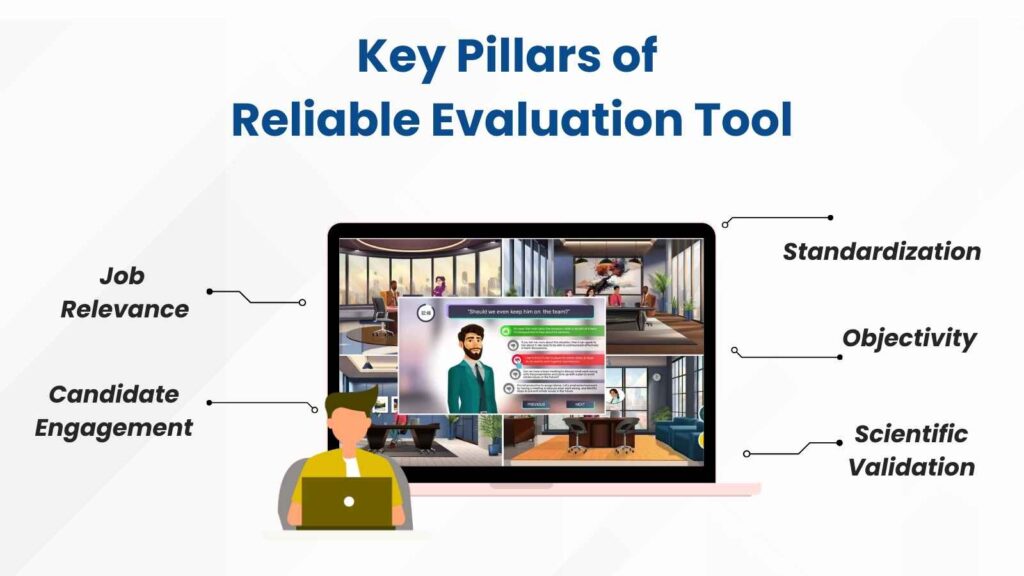
How to Audit the Reliability of Your Current Process
Before overhauling your candidate evaluation system, it’s essential to assess how well your current process performs. Many organizations assume their hiring methods are effective until inconsistencies or poor hires reveal otherwise.
Start by reflecting on how consistently your evaluators identify top candidates. If interviewers disagree often, your process might lack the structure needed for reliability. Similarly, ask whether your assessment results actually predict on-the-job success. A reliable system should correlate strongly with performance, retention, or growth potential.
You should also evaluate the scientific foundation of your tools. Are your assessments validated by psychologists or trusted HR experts? Using non-validated tools increases the risk of bias and poor decision-making.
Finally, consider scalability. Can your process handle campus drives or bulk hiring without sacrificing fairness or speed? Inconsistent experiences across candidates often lead to unreliable outcomes.
Here are some key questions to guide your audit:
- Do evaluators consistently agree on top candidates?
- Are your assessment results linked to post-hire performance?
- Are your tools scientifically validated?
- Can the process scale efficiently for large hiring volumes?
If you’re uncertain about any of these, your current evaluation process likely has reliability gaps that need urgent attention.
Building a Reliable Evaluation Process in 2025: A Step-by-Step Approach
Designing a reliable hiring process requires more than just good intentions, it calls for structure, science, and strategy. Here’s how to build one that works in 2025 and beyond:
1. Start with Role Analysis
Begin by defining success. What are the must-have skills, values, and behaviors for the role? A clear role analysis lays the foundation for consistent and relevant evaluation.
2. Choose the Right Tools
Select scientifically validated assessments that measure what matters, cognitive ability, behavioral traits, and cultural alignment. Tools grounded in psychology ensure reliability and predictiveness.
3. Structure Your Interviews
Ditch the free-flowing chats. Instead, use standardized questions, scoring rubrics, and trained interviewers. Structured interviews are proven to be more predictive and fair.
4. Integrate Technology
Adopt modern tools like AI-based screening or gamified assessments. These not only enhance consistency but also make your process scalable for bulk or campus hiring.
5. Validate and Iterate
A reliable process isn’t static. Track post-hire performance, monitor dropout rates, and refine the system regularly. Continuous improvement keeps your evaluation relevant and effective.
By following these steps, companies can minimize guesswork and bias by building a hiring engine that delivers consistently strong talent.
Why Gamified Assessments Help Ensure Reliability
Gamified assessments are more than just interactive tools, they’re grounded in behavioral science and built to deliver consistent, bias-free evaluation at scale. Tools like C-Factor by The Talent Games offer a reliable, validated alternative to traditional methods by embedding Situational Judgment Tests (SJTs) in an engaging format. Here’s how they ensure consistency, fairness, and accuracy.
Standardized Gameplay Experience
Every candidate goes through the same storyline, challenges, and decisions, ensuring uniformity across the board. This eliminates variability often caused by different interviewers or environments during traditional assessments.
Objective, Data-Driven Scoring
Each micro-action, decision-making speed, option chosen, and behavior patterns is tracked and scored through algorithms. This removes gut-feel scoring and enables fully objective comparisons between candidates.
Elimination of Visual and Social Bias
Gamified SJTs are designed to exclude resumes, photos, or voice, removing cues that often lead to unconscious bias. What’s measured is actual decision-making and behavior, not identity or background.
Scientific Validation for Accuracy
C-Factor, the award winning gamified assessment platform, is developed with I-O psychologists and undergoes reliability and predictive validity testing. This ensures the assessment consistently measures traits that are linked to job performance.
Hybrid Compatibility for Broader Use
Gamified tools work best when used with structured interviews or job simulations. This hybrid model strengthens reliability by combining immersive assessment with human judgment, especially in high-stakes or leadership hiring.
How Gamified Assessments Align With Hiring Needs in 2025
Building on the need for reliable evaluations, gamified assessments check all the boxes—especially in today’s fast-paced, candidate-driven market.
🔹 Short-Term Wins
• High Completion Rates:
Over 80% of candidates complete gamified assessments, even in bulk hiring, thanks to their immersive design.
• Faster Screening:
Real-time scoring and data-driven insights speed up early-stage decisions.
• Instant Analytics:
Recruiters gain immediate visibility into key candidate traits cognitive ability, behavior, and fit.
🔹 Long-Term Value
• Stronger Quality of Hire:
By assessing job-relevant competencies, these tools reduce the risk of hiring mismatches.
• Lower Early Turnover:
Better alignment leads to higher retention in graduate and MT programs.
• Improved Employer Brand:
A gamified experience reflects innovation and attracts next-gen talent.
Companies like Nestlé, Engro, and Coca-Cola already rely on this hybrid, scalable model to future-proof their hiring.
Use Cases: Where Gamified Tools Excel
Gamified evaluations aren’t one-size-fits-all and they shine most in roles and scenarios where engagement, scale, and behavioral insights matter most.
🔹 Campus & Management Trainee Programs
For high-volume hiring with limited recruiter bandwidth, gamified assessments are a game-changer. Companies like Nestlé, HBL, EBM, and Jazz have consistently used The Talent Games’ platform to identify high-potential interns and management trainees. The interactive format boosts engagement while ensuring only the most capable candidates move forward.
🔹 Retail & Sales Roles
These frontline roles demand adaptability, communication, and fast thinking. Gamified tools assess these traits in real-time, helping recruiters shortlist candidates with the right on-ground instincts.
🔹 Leadership Pipelines
Beyond hiring, companies like Philip Morris International have used gamified assessments to identify and nurture leadership talent. These simulations help assess soft skills and strategic thinking, while also boosting employer branding and employee engagement.
By aligning game mechanics with the job’s competency framework, these tools uncover top performers traditional methods might overlook.
Common Mistakes to Avoid in the Evaluation Process
Even well-intended strategies fall short without a strong foundation. To ensure your evaluation process stays reliable, avoid these pitfalls:
Skipping role analysis before designing assessments
Using tools without scientific validation
Relying on too many disconnected platforms
Overlooking the candidate experience
A reliable process is structured, validated, and aligned with your hiring goals, not just built on trending tools.
Final Thoughts: What Makes Your Process Reliable and Future-Proof
In 2025, a reliable candidate evaluation process is one that consistently predicts on-the-job performance, maintains fairness across recruiters and regions, and is rooted in scientific validation. It must also be scalable for high-volume hiring while providing a smooth, engaging experience for candidates. Reliability today goes beyond gut feeling, it requires structured, evidence-based decision-making.
Tools like C-Factor, a gamified assessment by The Talent Games, help bring this vision to life. By combining behavioral science, interactive design, and robust analytics, gamified tools offer a future-ready solution that doesn’t feel mechanical or impersonal. If you’re serious about improving hiring outcomes this year, start by asking yourself:
“Is your evaluation process truly reliable, or just comfortably familiar?”
